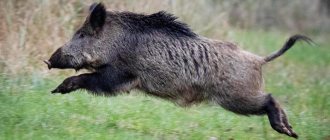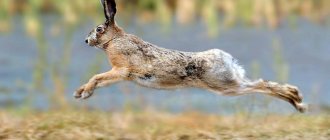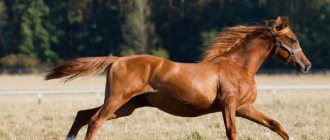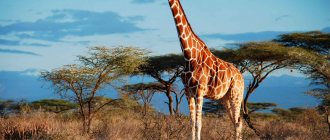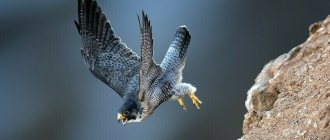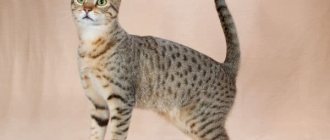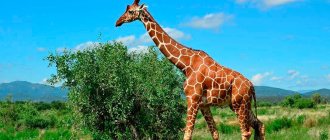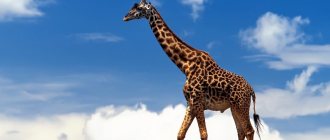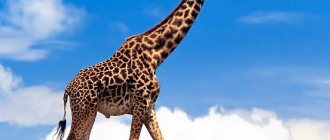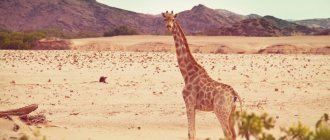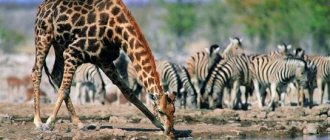The giraffe belongs to the order of ruminant artiodactyls. Its habitat is exclusively in Africa. In Arabic it is pronounced "serafe", which translates as sweetheart. This is one of the most beautiful and unusual living creatures on Earth, the uniqueness of which lies in its growth. Today, the giraffe is the tallest artiodactyl animal in the world. According to observations and research by scientists, the growth of a giraffe ranges from 5-6 meters.
Giraffe - description and appearance
The giraffe is a very unusual representative of the fauna. No other mammal on Earth has a neck of such length. It would seem that it should have a special structure, but no, it has 7 cervical vertebrae, just like any other mammal. The length of each of them is 25 cm. Blood circulates through the neck evenly and with the same pressure, since the animal anatomically has special locking valves. They are located in the main cervical artery.
The closest relative is the forest giraffe - okapi, and the most distant relative is the deer.
An accurate description of a giraffe cannot be without emphasis on its eyes. He has impeccable vision, and his long neck helps him increase his visibility around him. Therefore, he notices approaching danger even at a distance of 2 km. In this case, the animals gather in a large herd in order to jointly defeat the enemy. Males use their hooves to scare away predatory animals.
In addition to excellent vision, the giraffe also has very developed hearing. If they hear any suspicious sound, they can immediately go on the run. At first glance, the giraffe looks quite clumsy, but they can reach good speed, up to 60 km/h. They move in leaps that range up to 5 meters. The mammal can jump over obstacles 1.5 meters high. The giraffe's limbs are quite thin when compared with the overall size of the legs. They move better and more actively on solid soil than in swamps.
On the head, both males and females have a pair of horns. They are covered with wool. The giraffe's eyes are large and pronounced, and they are framed by long eyelashes.
The only place where giraffes live is Africa, and as you know, the air temperature is high there. To survive in this environment, an animal must be able to adapt to the local climate. Giraffes graze exclusively in the morning, until the heat sets in, after which they go to rest in the shade and chew cud. In addition, their skin has a light sand color, which also prevents the animal from overheating.
Giraffe height and weight
The height of a giraffe on average ranges from 5 to 6 meters, with the neck taking up 30% of it. Weight ranges from 500-1900 kg. It depends on what species the animal belongs to. The appearance of a giraffe creates the impression of an elegant and graceful representative of the fauna. Therefore, it is very difficult to imagine that some individuals can weigh almost 2 tons.
The giraffe is by far the tallest of all living mammals. Scientists say they can reach 7 meters. But the officially recorded tallest giraffe lived at Chester Zoo in England. His height was 6 m.
The animal's heart weighs about 12 kg. This allows you to distill 60 liters of blood per minute.
At birth, the giraffe is about 150 cm tall and weighs 100 kg. An hour after birth, he is already fully on his feet.
Color, tongue size
One of the most interesting parts of the giraffe's body, besides the neck, is the tongue. The first thing you notice is its color: dark, sometimes even almost brown or purple. In addition, the giraffe's tongue is a very strong muscle, which makes it possible to tear branches from trees or their leaves located at great heights. Scientists have recorded that the length of a giraffe's tongue is 40-45 cm. This allows the long-necked animal to clean its own ears and drive annoying insects away from its face.
The animal feeds on any plants, some of which may have thorns, so the tongue has become hard and strong so that it does not suffer from various damage during eating.
Thanks to this unique feature of the structure of the tongue, the giraffe is saved from drought, which can often be observed where the animal lives. All lower leaves and grass are eaten by low-growing animals. Therefore, the giraffe has no choice but to eat leaves from the very tops of the trees, which no one has reached.
Features of the neck structure
The cervical skeleton includes only 7 vertebrae. This amount is typical for the structure of the neck of almost all species of mammals. The neck is long solely due to the structure of the vertebrae - each vertebra is strongly elongated .
Another feature is that the thoracic vertebra, the one immediately behind the cervical vertebra, is greatly modified. It looks more like one of the cervical vertebrae.
Blood pressure . Due to their high growth, giraffes have a colossal load on the heart and the entire circulatory system. The heart is well developed and strong enough to withstand record high blood pressure.
Its indicators are three times higher than human indicators. In turn, such blood pressure is necessary so that blood can flow freely from the heart to the brain. When the head is raised, pressure is in the skull.
Lowering your head could risk a dangerous increase in pressure. To prevent up and down movements of the neck from causing instant death, nature provides “safeties” :
- Blood is thick and has an increased density compared to human blood.
- There is a special protective mechanism, two vascular formations.
Due to these indicators, blood pressure is normalized . Venous valves allow blood to flow only in one direction, to the heart, and prevent reverse flow to the brain.
Animal's maximum speed
Despite the fact that the height of the giraffe is quite large, and it seemed that this could interfere with high-quality running, however, they are considered very fast animals. If necessary, animals can run at a gallop. So, their maximum speed can be almost 55 km/h .
This means that giraffes can outrun a horse. However, these majestic animals often prefer to move slowly. The giraffe walks, simultaneously moving first one pair of hooves to the right, then to the left. Animals walk exclusively on hard surfaces. This is due to their height and thin legs.
However, an interesting fact is that, given their height, giraffes are capable of jumping . Sometimes they are even able to overcome obstacles and barriers higher than one and a half meters.
Giraffe color
This mammal has a unique color. The spots on the skin form certain patterns, so it is not always clear what color the giraffe is. Each has its own unique color. It is not repeated among other individuals, but is exclusively individual for each animal. The location, size and color of the spots can be compared to human fingerprints. There are no people in the world with the same fingerprints. Therefore, it is impossible to find two absolutely identical representatives of this species in nature.
How do giraffes sleep?
Many people are interested in the question: “How and how much does a giraffe sleep?” Everything is very simple. He curls up and rests his head on his rump. The height of the giraffe does not allow this to be done quickly. To assume this position, the mammal must first bend its legs. One limb must be moved to the side. After which he takes a comfortable position. In addition, giraffes also sleep in a standing position. The long-necked one sleeps short. Usually about 10 minutes is enough for him to sleep. At the same time, a giraffe sleeps no more than 2 hours per day. Even at night he constantly gets up to drink some water or have something to eat.
Types of giraffes
The giraffe family includes 1 species. There were 5 more, but they are all already extinct. The animal with the longest neck is classified according to its habitat and the type of pattern on its skin. Today, the following subspecies of giraffes are distinguished:
- Nubian. It is found in eastern Sudan and western Ethiopia. The color contains chestnut spots, which are outlined by white lines.
- Ugandan. His second name is Rothschild. Uganda became his habitat. It is famous for its brown spots, which are separated by white stripes. They have a fairly large shape.
- Reticulate. Also called Somali. It can be found on the northern side of Kenya and southern Somalia. Their color is distinguished by rich spots of brown-red hue, which are framed by thin white lines. They are medium in size and have sharp edges.
- Angolan. Lives in Namibia and Botswana. The color is distinguished by brown spots, which are quite large and noticeable from afar. Moreover, they have elongated corners.
- Kordofan. Its habitats are considered to be western Sudan and the Central African Republic. This mammal's spots on its body are unevenly distributed.
- Maasai. Lives in southern Kenya and Tanzania. The spots vaguely resemble a star in shape and are most concentrated in the leg area.
- South African. Found in Zimbabwe, South Africa and Mozambique. The giraffe has a golden skin, decorated with round spots of dark color.
- Thorneycroft. Lives in Zambia and is distinguished by its light skin with spots with sharp edges that have dark shades.
- West African. This species has practically disappeared from the face of the Earth. According to data for 2007, there were 175 individuals in the world. Its natural habitat is Chad.
Giraffe habitat
Giraffes live in the wild in Africa. This is the only continent where they can be found in their natural habitat. Herds of giraffes or individual individuals are found in the southern and southeastern regions of the Sahara Desert. In addition, they began to live in even more arid areas of African land where people do not live. Thanks to their bodies and low water consumption, these mammals exist comfortably in the open forests of Africa.
Previously, long-necked animals were subject to total hunting, so they had to change their usual habitats. Today they are found in places where they were not previously found.
Who eats them?
Adult giraffes are inaccessible to most predators, who mainly hunt young or sick animals. But sometimes, at a watering hole, these mammals can easily become victims of crocodiles, lions, leopards, spotted hyenas, and wild dogs.
After such a close acquaintance with the African giraffe and learning interesting details about it, you will once again be convinced of the beauty and fragility of our nature.
Giraffe nutrition
The giraffe has a four-chambered stomach, so many people are curious about what a giraffe eats. He is completely dedicated to eating plant-based foods. The animal chews leaves and tree branches using its ruminant jaw. This is done very carefully and slowly. Giraffes regurgitate leftover food from the first chamber of the stomach in order to chew it again. This process is called chewing cud.
Africa has a very arid climate, so not everyone knows what giraffes eat to survive in these difficult conditions. But in the course of evolution they adapted to such conditions.
The height of a giraffe will always help it find food. The animal primarily feeds on succulent acacia. Mimosa or wild apricot shoots can replace it. The food that a giraffe eats can weigh up to 30 kg per day, so it spends 16 to 20 hours a day obtaining and chewing it. If the leaves eaten are juicy enough, the animal can be without water for a long time.
In order to drink, the giraffe must spread its legs wide enough and tilt its head towards the pond. In one such approach, he can drink 38 liters of liquid.
If a long-necked animal lives in a zoo or nature reserve, then its menu there is somewhat more varied than in the wild. The diet consists of leaves, grass, in particular clover, hay, and some vegetables and fruits are also added, such as bananas, oranges or carrots. In addition, the long-necked mammal likes to feast on bread. Workers always take care of their pets, and to make the spotted long-necked animal more comfortable, all food and water are raised to the level of their heads.
Small giraffes feed on mother's milk after birth and up to 4 months. After this period, the baby needs to be taught to eat on his own.
Giraffe diet
These animals are classified as herbivores, a group of ruminants. The physiology and structure of their body make it possible to feed on leaves from high tree crowns. Based on where the giraffe lives, this allows it to remain out of competition compared to other species.
The most delicious leaves for them are acacia leaves . Covering the branch with its long tongue, the giraffe pulls it to its mouth and then plucks the leaves. At the same time, the head is pulled back. Despite the fact that the branches are often thorny, the oral cavity and tongue are not damaged in any way.
One representative of these animals can consume up to 30 kilograms of greens . This takes at least up to 16 hours. It happens that a giraffe can spend about 20 hours doing this activity. It has been noticed that males and females eat differently. Male individuals nibble leaves from the very tops.
Giraffe breeding
In their natural habitat, giraffes most often live alone or group in a small herd. Antelopes or zebras become their neighbors. Interesting facts about giraffes say that they are polygamous. The male protects his females from all outside contenders for their hearts. At the same time, the male does not mind mating with new females that come into his field of vision.
A favorable period for having offspring is the rainy season. On the African continent it lasts from July to September. The gestation period is about 14-15 months. If conception occurred on time, then its birth will occur just during the dry period, which will give the little giraffe the opportunity to stand firmly on its feet. The female gives birth standing. Therefore, the cub has to fall from a height of almost two meters. Scientists were able to record how much a giraffe weighs immediately after birth. The weight of a newborn is approximately 100 kg. The height of a giraffe at birth is 150 cm.
The marriage games are very beautiful and theatrical. First, the male must carefully sniff the female’s fresh urine and judge from her smell whether she is ready for the mating process. After this, he begins to rub his head against the sacrum. After which he carefully places his head on the female’s back. If she accepts these advances, she moves her tail to the side. That is, it allows the male to approach.
A baby giraffe is born without horns. In their place, he grows black hair. Underneath it is cartilage. As the giraffe grows, it ossifies, after which it transforms into small horns. Hair also disappears as we grow older.
Giraffe
The giraffe is a mammal from the order Artiodactyls. The giraffe is the tallest animal on the planet. The giraffe is an intelligent and peace-loving animal that has been familiar to us since childhood. In this article you will find a photo and description of a giraffe, and also learn a lot of interesting things about this unique and wonderful animal.
The description of the giraffe can begin first of all with its growth. The giraffe looks very tall. After all, the giraffe is the record holder in the animal world for height and is one of the largest animals. The giraffe grows up to 6 meters in height. The weight of a giraffe is 1 ton. Male giraffes are taller than females. In addition, females weigh slightly less.
The giraffe's height is 1/3 of its neck, which is unusually long and slender. The giraffe's neck has 7 cervical vertebrae. Many other mammals, even those with short necks, have the same number of vertebrae; it’s just that the giraffe’s vertebrae are elongated. The giraffe's neck is unusually strong, as it has strong muscles that allow it to hold its head and maneuver well.
Since giraffes are tall and have a long neck, their circulatory system works under increased stress. Therefore, giraffes have a very strong heart. The giraffe's heart weighs 12 kg and passes 60 liters of blood per minute, creating a pressure 3 times higher than that of a human.
But even such a strong heart of a giraffe cannot withstand overload if the animal suddenly lowers and raises its head. Nature made sure that such stress did not have dire consequences and made the giraffe’s blood thicker. In addition, it contains 2 times more blood cells than a person. The giraffe also has special valves that help keep the pressure in the main artery at the same level.
The giraffe looks unusual not only because of its height. The giraffe's strong body is covered with short hair. The color of the giraffe's coat adds to the uniqueness of the giraffe's appearance. The coat pattern of each giraffe is formed by a unique pattern of dark spots that stand out against the background of a light shade of the base color. This pattern is absolutely unique, like a human fingerprint. From below, the giraffe's body is lighter in color and has no spots. Young individuals are lighter in color than older ones.
The giraffe looks funny, because its head with small ears has two horns covered with hair. Both sexes have horns. Females have thinner horns and have tassels. In males they are thicker and the coat is smoother. Occasionally, giraffes have two pairs of horns. Giraffes often have a convex bone growth on their forehead that looks like a horn. The giraffe looks charming, because its huge black eyes have thick eyelashes. The giraffe has a thin, long tail with a black tassel at the end and a small short mane on its neck.
Giraffes have good eyesight, hearing and smell; such abilities help them spot danger in time. And of course, the large growth of giraffes allows for a good overview of the area. Giraffes can see each other at a distance of up to a kilometer. The giraffe's tongue is dark in color, often with a purple tint. The giraffe's tongue is 45 cm long and helps the animal grab branches. The giraffe's long neck allows it to reach the highest crowns.
The giraffe's legs are strong and high, with the front ones being longer than the back ones. Giraffes run fast. If necessary, the giraffe can gallop at a speed of up to 55 km/h. Thus, the animal giraffe can outrun a racehorse in short distances. But most often, giraffes move slowly, first moving their two right hooves, then both left ones. When walking this way, the giraffe's speed is up to 7 km/hour.
Since the giraffe has a lot of weight and thin legs, it moves only on a hard surface. Therefore, the animal giraffe avoids swampy areas. Rivers are almost insurmountable for giraffes. It is noteworthy that these huge animals can jump over barriers up to 180 cm high.
Currently there are 4 species of giraffes and 9 subspecies. They all differ in the pattern of their fur and the color of their spots. Giraffe species are divided into: southern giraffes, Masai giraffes, reticulated giraffes and northern giraffes.
Modern giraffe subspecies include the Nubian giraffe, West African giraffe, Kordofan giraffe, reticulated giraffe, Ugandan or Rothschild's giraffe, Masai giraffe, Thorneycroft's giraffe, Angolan giraffe and South African giraffe.
Giraffes live in Africa, living in its arid parts. Today, giraffes live south and southeast of the Sahara. Giraffes live in savannas and woodlands, primarily in Eastern and Southern Africa.
In the 20th century, the number of giraffes decreased significantly due to uncontrolled hunting, various diseases and the destruction of natural habitats. Today, the largest number of giraffes live in protected areas of national parks. Giraffes are one of the few animals that feel good in captivity and regularly bear offspring.
Giraffes live practically without sleep; among all mammals they have the least need for it. A giraffe sleeps on average no more than 2 hours a day. But sometimes a 10-minute nap is enough for them. Surely everyone has wondered how giraffes sleep? They're so tall. Giraffes sleep both standing and lying down. In a lying position, a sleeping giraffe bends its neck, tucks its legs and rests its head on its rump.
Giraffes live in small herds or alone. There is no strict loyalty in herds. Everyone can freely leave the herd or also freely move to another. The size of the herd varies depending on the season and can range from 4 to 32 individuals. A herd of giraffes can consist of individuals of different sexes or of the same sex. In search of food, the giraffe animal can travel up to 100 km². Quite often you can see giraffes moving along with herds of antelope or zebra. This way they are safer.
The hierarchy and social behavior of giraffes in a herd are not yet fully understood. Although giraffes do not have a main leader, older and stronger males have an advantage over others. Also in herds where there are only females, the oldest female takes the lead. When two adult males meet, skirmishes often occur between them. In a duel, they try to headbutt each other in the neck. Despite this, defeated males are not expelled from the herd, unlike other social animals, such as wolves.
The mating season is also often accompanied by fights between males, but at this time they become much more aggressive. Opponents can sort things out near a tree, with each trying to press the opponent to the trunk and deliver a headbutt to the neck. Fortunately, giraffes do not use their main weapon on each other - dangerous blows with their front hooves. At least such cases have not been observed. They usually use their hooves to defend themselves against predators. The winner does not pursue the defeated male.
Giraffes are mistakenly considered voiceless animals. They simply communicate with each other at low frequencies, which are indistinguishable to human hearing. However, giraffes do make sounds that we can hear. They can snort, whistle and roar, thus alerting their relatives in case of danger, as well as when searching for lost cubs.
Very often you can see various small birds on the backs of giraffes. There is a friendship between giraffes and these birds that is built on mutual assistance. These birds clean the giraffe's back and neck of insects. In this way, giraffes get rid of parasites, and birds get food.
The giraffe is a herbivore animal. Therefore, giraffes eat exclusively plant foods. Due to their body structure and physiology, giraffes eat the foliage of tree crowns located at considerable heights, where there is no competition. Giraffes eat acacia, giving the greatest preference to this tree.
The giraffe grabs the branch with its long tongue and pulls it towards its mouth to pluck the leaves, while pulling its head back. The acacia tree has thorny branches, but the giraffe's tongue and lips are designed in such a way that they allow feeding without damage.
A giraffe eats up to 30 kg of food per day, spending most of its time eating. In times of famine, 7 kg of food is enough for a giraffe. It is curious that by the way giraffes eat, you can determine the sex of the animal from a distance. Male giraffes eat mainly very high-growing leaves, while they strongly stretch their necks and throw back their heads. Female giraffes eat leaves that grow at the level of their body, so they usually lower their necks slightly.
The animal giraffe can go without water even longer than a camel. After all, food completely covers his need for liquid. However, if a giraffe has the opportunity to drink, it can drink up to 38 liters of water at a time. To drink water, a giraffe must spread its front legs wide apart and lower its head quite low. This position makes the giraffe clumsy and vulnerable to predators, so giraffes drink only when they are confident in their safety. In the same position, giraffes pluck grass when hungry.
Giraffes are polygamous animals. Females become capable of reproduction at the age of 3-4 years, but produce offspring for the first time by 5 years. In males, the breeding season begins at the age of 4-5 years. Young males find it difficult to compete with older males. Therefore, young animals can acquire offspring only by the age of 7 years.
The mating season for giraffes is from July to September. The duration of a giraffe's pregnancy is 14-15 months. Usually only one giraffe calf is born. Giraffes give birth standing up, which means that a giraffe calf falls from a height of about 2 meters at birth. There is no need to worry; the baby giraffe does not suffer any injuries from the fall.
A born giraffe calf is 180 cm tall and weighs 50 kg. An hour after birth, the cub gets on its feet, and after a few more hours it can run. Giraffe cubs are only allowed into the general herd after a few weeks, at which time they begin to browse the grass. But the baby giraffe will feed on mother’s milk until almost 1 year of age.
Giraffes have nurseries to which females send their young. In this way, mothers may separate from their young to find food and water. Monitoring duty over a group of cubs occurs between mothers in turns.
Giraffe cubs are born without horns, but where they appear there is a tuft of dark hair, under which there is cartilage. As they grow older, the cartilages harden into horns that begin to grow. Tufts of black fur at the base of the horns remain with the cub for several years, after which they disappear.
Giraffe cubs grow quickly, they are mobile and very active. Until approximately 1.5 years of age, the giraffe calf remains with its mother. After which he begins an independent life. Males usually leave their native herd, but females almost always remain in it. In the wild, giraffes live for about 25 years, and in captivity up to 35 years.
Due to its considerable size, the giraffe animal has practically no natural enemies. Giraffes defend themselves from predators by striking their front hooves. Such a blow can break the skull of any predator, although there are cases of predators defeating giraffes.
Few predators are willing to take risks, so attacks on adults are rare. Predators most often attack young animals. Despite the mother's protection, up to 50% of young giraffes become prey to lions, leopards, hyenas and wild dogs.
Share link:
Life expectancy of giraffes
How many years does a giraffe live? Of course, such a large animal should live a very long time, but the average age is 20-23 years. The maximum age a giraffe lived was 28 years. The cub is with its mother from the moment of birth until 1.5 years of age. At 4 years old it becomes sexually mature.
In captivity, life expectancy increases and can reach about 30-35 years.
Reproduction and lifespan
Giraffes are polygamous and do not form stable pairs. The male recognizes the female's readiness by smell and immediately tries to begin mating. The male proves his right to reproduce by engaging in single combat with rivals.
The main offensive means is head strikes. But, despite the power of the blows, there are no fatalities.
The female's pregnancy lasts 400-460 days. She gives birth to one calf, and occasionally twins are born. The height of the foal reaches 1.7-2 meters. After a few hours, he can already run and becomes a full member of the herd.
The giraffe has been successfully kept and bred in captivity. As the most interesting animal of the zoo, the giraffe always attracts the attention of the public. It still arouses no less interest among zoologists. When kept in captivity, he (giraffe) lives up to 20-27 years. In the African savannah its life is half as long.
